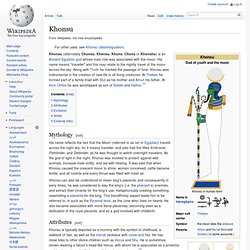

Iah. Iah ( Egyptian: Jˁḥ, transliterated as Yah, Jah, Jah(w), Joh or Aah [2]) is a god of the moon in ancient Egyptian religion.

His name simply means moon. By the New Kingdom he was less prominent as a moon deity than the other gods with lunar connections, Thoth and Khonsu. As a result of the functional connection between them he could be identified with either of those deities. He was sometimes considered an adult form of Khonsu and was increasingly absorbed by him. Iah continued to appear in amulets and occasional other representations, similar to Khonsu in appearance, with the same lunar symbols on his head and occasionally the same tight garments. Iah was also assimilated with Osiris, god of the dead, perhaps because, in its monthly cycle, the moon appears to renew itself.
See also[edit] Yarikh References[edit] Jump up ^ Allen, James P. (2000). Thoth. Thoth played many vital and prominent roles in Egyptian mythology, such as maintaining the universe, and being one of the two deities (the other being Ma'at) who stood on either side of Ra's boat.[5] In the later history of ancient Egypt, Thoth became heavily associated with the arbitration of godly disputes,[6] the arts of magic, the system of writing, the development of science,[7] and the judgment of the dead.[8] Name[edit] Etymology[edit] The Egyptian pronunciation of ḏḥwty is not fully known, but may be reconstructed as *ḏiḥautī, based on the Ancient Greek borrowing Θώθ [tʰɔːtʰ] Thōth or Theut and the fact that it evolved into Sahidic Coptic variously as Thoout, Thōth, Thoot, Thaut as well as Bohairic Coptic Thōout.

According to Theodor Hopfner,[12] Thoth's Egyptian name written as ḏḥwty originated from ḏḥw, claimed to be the oldest known name for the Ibis although normally written as hbj. Further names and spellings[edit] Hathor. Hathor (/ˈhæθɔr/ or /ˈhæθər/;[2] Egyptian: ḥwt-ḥr and from Greek: Άθωρ, "mansion of Horus")[1] is an Ancient Egyptian goddess who personified the principles of joy, feminine love, and motherhood.[3] She was one of the most important and popular deities throughout the history of Ancient Egypt.

Hathor was worshiped by Royalty and common people alike in whose tombs she is depicted as "Mistress of the West" welcoming the dead into the next life.[4] In other roles she was a goddess of music, dance, foreign lands and fertility who helped women in childbirth,[4] as well as the patron goddess of miners.[5] The cult of Hathor predates the historic period, and the roots of devotion to her are therefore difficult to trace, though it may be a development of predynastic cults which venerated fertility, and nature in general, represented by cows.[6] Hathor is commonly depicted as a cow goddess with horns in which is set a sun disk with Uraeus. Early depictions[edit] Temples[edit] Isis.
Temple of Isis in Philae, Egypt Isis (Ancient Greek: Ἶσις, original Egyptian pronunciation more likely "Aset" or "Iset") is a goddess in Ancient Egyptian religious beliefs, whose worship spread throughout the Greco-Roman world.

She was worshipped as the ideal mother and wife as well as the patroness of nature and magic. She was the friend of slaves, sinners, artisans and the downtrodden, but she also listened to the prayers of the wealthy, maidens, aristocrats and rulers.[1] Isis is often depicted as the mother of Horus, the hawk-headed god of war and protection (although in some traditions Horus's mother was Hathor). Isis is also known as protector of the dead and goddess of children. This myth became very important during the Greco-Roman period. Khonsu. Khonsu, the ancient Egyptian moon-god, was depicted either as a falcon wearing the moon-disk on his head (left) or as the child of Amun and Mut.

Khonsu (alternately Chonsu, Khensu, Khons, Chons or Khonshu) is an Ancient Egyptian god whose main role was associated with the moon. His name means "traveller" and this may relate to the nightly travel of the moon across the sky. Along with Thoth he marked the passage of time. Khonsu was instrumental in the creation of new life in all living creatures. At Thebes he formed part of a family triad with Mut as his mother and Amun his father.